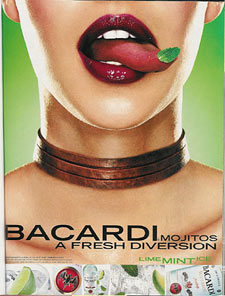Rum - Caribbean Class

Rums are as diverse as whiskies, and much depends on how the distiller and blender create their product. Rum is also thought to be the world's oldest spirit with its cultural heritage centered in the Caribbean and its history inextricably intertwined with colonialism, slavery and the creation of capitalism.
The history of rum is largely the history of sugar, the sweet crystalline carbohydrate that occurs naturally in a variety of plants, but in particular, the sugar cane - a tall, thick grass that has its origins in present-day New Guinea & Indonesia. Chinese traders spread its cultivation to Asia and on to India. It is thought that the armies of Alexander in about 325 B.C. enabled this"reed [which] brings forth honey without the help of bees" to reach the Mediterranean. Arabs in turn brought it to the Middle East and North Africa where it came to the attention of Europeans during the Crusades in the 11th century.
When Christopher Columbus took cane cuttings from the Canary Islands to the Caribbean, it was rich 'muscovado' sugar he planned to ship back to Spain. The first cane fields were planted on Hispaniola (now the Dominican Republic and Haiti), and as the Spaniards spread through the islands, other fields were planted on Cuba, Jamaica, Puerto Rico and along the Latin American coast, the Caribbean basin having an ideal climate for growing the cane. An insatiable European demand for sugar quickly led to the establishment of hundreds of sugar cane plantations and mills in the various English, Spanish, French, Portuguese, and Dutch colonies. By 1625, the Portuguese nation of Brazil was supplying most of Europe's sugar. At this time, the sugar was not being distilled.
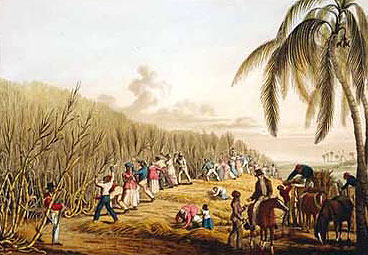 |
| An early plantation scene. |
Rum most likely began its life as a by product of sugar production, in much the same way as Scottish farmers looking for a use for their surplus barley or settlers of the American west with their excess corn, used their grain to make malt whisky and bourbon. Molasses is a sticky syrup that contains a significant amount of sugar. Sugar mill operators soon noticed that when it was mixed with water and left out in the sun it would ferment. The Spaniards already knew how to utilise the cane syrup left after making muscovado. The Moors had introduced the art of distilling to Spain, though for medicinal purposes, and when they departed they left behind the art, and extensive sugar cane fields around Malaga. The Spanish already had the secret of rum and"...By 1650, the British (in Barbados) and French (on Martinique) had established the plantation system. The Caribbean was about to become a massive sugar making factory and distillery."(1)
The former waste product was now being distilled, but mostly without expertise, and the results were according to one unknown source,"a hot, hellish and terrible liquor".In the English colonies it was called 'Kill Devil' (from its tendency to cause a nasty hangover or for its perceived medicinal power, take your choice) or 'rumbullion' (origins uncertain), which was shortened over the years to our modern word 'Rum'. The French render this word as 'rhum', while the Spanish call it 'ron'. There are many other synonyms for this tropical spirit: 'Barbados Water', 'Grog', 'Demon Water', 'The Pirate's Drink', 'Navy Neaters', 'Nelson's Blood', 'Rum Bastion' & 'Comfortable Waters' amongst others. Each name is historically and / or culturally cogent, indeed, it is impossible to write about rum without touching on the origins and variations of the word itself.
If it was not being drunk, rum was being used a form of currency or medicine. Locally, the spirit was a cure-all for many of the aches and pains that afflicted those living in the tropics. Sugar plantation owners also sold it, at discounted prices, to naval ships that were on station in the Caribbean in order to encourage their presence in local waters and thus discourage the attentions of marauding pirates. Indeed, the spirit's somewhat romantic association with piracy began with English privateers trading on the valuable commodity. As some of the privateers became pirates and buccaneers, their fondness for rum remained, the perception of the two only being strengthened by literary works such as Robert Louis Stevenson's Treasure Island.
This seafaring association with rum continued with the British Royal Navy in 1655 when the British fleet captured the island of Jamaica. With the availability of domestically produced rum, the British changed the daily ration of liquour given to seamen from French brandy to rum. While the ration was originally given neat, or mixed with lime juice, a practice of watering down the rum began around 1740 when Admiral Edward Vernon directed that the rum ration be diluted before being issued, a mixture which became known as 'grog'.
There are some rather amusing anecdotes associated with naval rum.
One concerns Horatio Nelson's body which, following his victory at the Battle of Trafalgar, was preserved in a cask of rum for transport back to England. Upon arrival the cask was opened and found to be empty of rum. The pickled body was removed and it was discovered that the sailors had drilled a hole in the bottom of the cask and drunk all the rum, in the process 'drinking' Nelson's blood. By the time he was buried, like the relics of a saint, the famed blood mixed rum was sought by every sailor worth his salt and sold by charlatans from Hudson's Bay to Tasmania. 'Nelson's Blood' subsequently became the common term for rum amongst seafarers as has "Tapping the Admiral" being used to describe drinking the daily rum ration. The traditional Royal Navy toasts went as follows:
 |
| Horatio Nelson. |
- Monday: Our ships at sea.
- Tuesday: Our men.
- Wednesday: Ourselves.
- Thursday: A bloody war and quick promotion.
- Friday: A willing soul and sea room.
- Saturday: Sweethearts and wives, may they never meet.
- Sunday: Absent friends and those at sea.
(These toasts are celebrated on certain limited edition
porcelain Ship's Decanters of British Navy Pusser's Rum).
The British Royal Navy continued to give its sailors a daily rum ration, known as a "tot" until July 31st, 1970 when the Admiralty Board abolished the daily issue of Pusser's Rum."Times had changed", they said, concluding that "in a highly sophisticated navy no risk for margin or error which might be attributable to rum could be allowed".
It was the naval-Rum connection that introduced Rum to the outside world and by the late 17th century a thriving export trade developed. The British islands shipped Rum to Great Britain (where it was mixed into Rum punches and replaced gin as the dominant spirit in the 18th century) and to the British colonies in North America and Australia where it became very popular.(In the early period of the Australian colony of New South Wales, the value of rum was based upon the lack of coinage, with its value such that convict settlers could be induced to work for it).
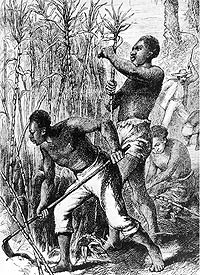 |
| Slaves harvesting sugar cane. |
The export of Rum to North America, in exchange for lumber and dried cod (still a culinary staple in the Caribbean) soon changed over to the export of molasses to distilleries in New England. By 1750, there were over sixty distilleries in Massachusetts and probably close to thirty on Rhode Island. Sugar represented the largest source of income for most estates, with large sugar exports fueled by Europe's ongoing demand. Slaves were a crucial element needed for the arduous work involved in cultivating sugar cane and the shipping of molasses to make Rum in New England became part of the infamous 'slavery triangle': On the first leg of the journey, a ship called a slaver was loaded with salt, cloth, weapons, hardware, beads, and rum. It sailed from a port in Europe to a port in Africa, usually one along the western coast. There, the ship's captain traded the cargo for Africans who had been enslaved. On the second leg of the journey, the grueling "middle passage" that lasted ten or more weeks, the Africans were tightly packed into the slaver's hold and shipped across the Atlantic. Once in the New World, Africans were either sold immediately to plantation owners or placed in stockades to be auctioned off when the demand was greater. To conclude the triangular trade, exotic plantation products such as sugar, molasses, tobacco, and rum were loaded into the slaver's now empty hold and shipped back to European markets. Cities like Newport and Rhode Island in America were effectively built on the profits of this slavery. Woodrow Wilson summed up the arrangement writing, "Out of cheap molasses of the French Islands, New England made the Rum which was her chief source of wealth. The rum with which she bought slaves from Maryland and the Carolinas paid her balances for the English Merchants."(2)
In short, the proliferation of sugar cane throughout the Caribbean Islands and the American continent was far from a story of peace and joy: "Every spoonful of sugar, every bowl of rum punch, was made on the back of slavery..." (3)
Almost a thousand vessels were engaged in the slave trade route and it is estimated that 45 million litres of rum were being enjoyed each year. In 1733 however, Parliament passed the first Molasses Act in order to capitalize on the successful rum business, laying excessive duty on importing products from foreign islands into the New World colonies. Only expensive molasses from the British part of the West Indies could be imported duty free. Many believe that the troubles caused by the Molasses Act led to the American Revolution. The Act represented the first attempt to legislate social customs and resulted in the first series of outbursts against the Mother Country.
Ironically, the disruption of trade caused by the American Revolution and the rise of whiskey production in North America resulted in the slow decline of Rum's dominance as the American national tipple. Rum production in the United States slowly decreased through the 19th century, with the last New England Rum distilleries closing at the advent of National Prohibition in 1920. During this time, famed rum-runners of the Prohibition era like Bill McCoy gained notoriety delivering genuine branded rum (hence the expression, the 'real McCoy'.)
In Europe the invention of sugar extraction from the sugar beet lessened the demand for Caribbean sugar, reducing the amount of molasses being produced and the amount of Rum being distilled. Many small plantations and their stills were closed. In Jamaica for example, in 1893, close to 90% of the 31, 555 acres under sugar cane cultivation belonged to sugar estates that operated their own mills and distilleries with some 148 distilleries located throughout Jamaica. By 1948 there were only 25. Since then the number of distilleries has dropped even further to 5. Rum production has receded, for the most part, to countries where sugar cane is still grown but the quality and range of products seems ever on the increase.
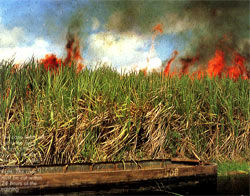 |
|
Burning out the 'trash'.
|
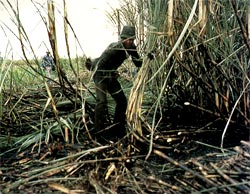 |
| Harvesting the cane. |
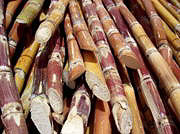 |
| Cleaned cane ready for processing. |
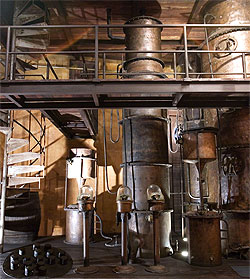 |
| Column stills. |
Producing Rum
Rum production begins in the cane fields where the russet stemmed commercial version of cane(Saccharum officinarum),as opposed to the eating variety, is grown, usually partly flooded for much of the growing season. As the sugar cane approaches maturity, its sugar concentration starts to increase. Different varieties of sugar cane will mature at different intervals depending on the weather. To optimize production, crops are monitored frequently to determine when they have reached the highest possible sugar yield. Harvesting sugar cane in the Caribbean is usually planned around the rain season and starts in November and goes through to the following Easter. It should begin at the end of the rain season, and stop when the mud of the new rain makes it impossible for trucks to enter the fields. First the field is put to the torch to clear away the dead foliage, though in Queensland, Australia, it also flushes out the snakes that thrive in the fields. Then it is cut within twenty four hours and taken to the sugar mills. The actual harvest can be done manually, which is very labor intensive and slow, or mechanically, which requires expensive machinery but is very fast. When the sugar cane leaves the fields, about 10 to 13.5% of its weight is sugar. It is now ready to have its juice extracted.
The cane is washed to remove dirt, dust, or loose material that does not contain sugar. Then the sugar cane is mechanically chopped into small pieces, and the fiber is removed. The amount of sugar extracted is directly related to the quality of the preparation it receives at this stage. Next, the cane is milled under large, heavy wheels to break up the tough cells and extract the juice. During the crushing, water is added to dilute and displace the cane juice. The juice is then heated, clarified and lime is added to bring the pH to near neutral, and the clear juice passes on to evaporators where the water is driven off to leave the sugar syrup. At this time, the concentration of sugar in the juice is about 16%. The syrup is boiled in a vacuum, and the crystals form a homogeneous mass with the molasses called 'mossecuite'. The sugar crystals are centrifuged out, and the molasses goes back for two further boilings. Blackstrap, the remaining syrup, becomes the raw material for making rum. The blackstrap is cleaned up, and is made ready for fermentation. Usually artificial yeasts are used to get it going, though sometimes a little wild yeast bearing bagasse is used. And if the distiller wants a more pungent rum, some dunder, (the residue from the stills), or limings, (the scum that forms on the surface of the molasses as the sugar is being taken out), may also be thrown in.
After a day and a half the molasses has fermented into the dead wash, though a longer time wilI produce a heavier style of rum. Since the turn of the century, the rum distillers have used both pot and continuous stills, the former producing the fuller flavoured, more estery rums, the latter the lighter or white rums. So by the type of still employed, the type of dead wash that goes into it, the temperature of the still and the length of the distillation cycle, a distiller can produce a variety of rums under the one roof.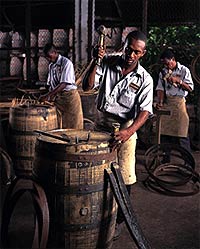 The next two stages of the cycle, maturation and blending, are just as critical as in any malt whisky or cognac house. After distillation, rums are about 96% alcohol by volume. At this strength, evaporation would be too rapid, so the rum is always diluted before aging. Different companies will dilute their rums to different strengths. For example, Caroni Limited from Trinidad, ages their rum at about 80% strength, while La Nacional from Guatemala ages theirs at about 60%. Traditionally one year old bourbon casks are filled with the new rum to gain colour and roundness . The use of bourbon casks for aging rum is rather recent, since bourbon itself was not aged in charred oak barrels until 1860. During aging, certain naturally occurring physical and chemical changes take place. These changes help "marry" the distillates stored in the barrels. During aging, the oxygen from the air goes in through the pores of the barrel to oxidize the alcohols into aldehydes and the aldehydes into acids. As time goes on, the acids react with the alcohols to produce esters. The time required for rum to be properly aged is usually in direct proportion to its body. Heavy-bodied rums will take longer to age than their lighter counterparts. Most rum-producing countries require rum to be aged for at least one year before it is bottled. Unlike the maturation of other noble spirits, many distillers argue that aging a rum for more than eight years is counterproductive. Imagine, for example, the case of Venezuela, where the spirit's evaporation rate due to heat and dryness is around 10% per year (compared to about 2% in Scotland and France).
The next two stages of the cycle, maturation and blending, are just as critical as in any malt whisky or cognac house. After distillation, rums are about 96% alcohol by volume. At this strength, evaporation would be too rapid, so the rum is always diluted before aging. Different companies will dilute their rums to different strengths. For example, Caroni Limited from Trinidad, ages their rum at about 80% strength, while La Nacional from Guatemala ages theirs at about 60%. Traditionally one year old bourbon casks are filled with the new rum to gain colour and roundness . The use of bourbon casks for aging rum is rather recent, since bourbon itself was not aged in charred oak barrels until 1860. During aging, certain naturally occurring physical and chemical changes take place. These changes help "marry" the distillates stored in the barrels. During aging, the oxygen from the air goes in through the pores of the barrel to oxidize the alcohols into aldehydes and the aldehydes into acids. As time goes on, the acids react with the alcohols to produce esters. The time required for rum to be properly aged is usually in direct proportion to its body. Heavy-bodied rums will take longer to age than their lighter counterparts. Most rum-producing countries require rum to be aged for at least one year before it is bottled. Unlike the maturation of other noble spirits, many distillers argue that aging a rum for more than eight years is counterproductive. Imagine, for example, the case of Venezuela, where the spirit's evaporation rate due to heat and dryness is around 10% per year (compared to about 2% in Scotland and France).
Finally the blender goes to work. First the blender is looking to produce a specific type of rum, say Jamaican golden, which means he or she will use lighter pot still rums given several years in a cask. Then consistency of style and flavour is sought. So if blending a dark rum, older pot still rum will be used, perhaps putting in some dry Plummer or powerful Wedderburn rum to give the final product more body, aroma and depth of flavour. The age makeup of a given rum is the complex combination of the different ages of the distillates used. Mount Gay's Master Blender explains:"It is not surprising, therefore, that any attempt to give a definitive declaration of age would be awkward, or conflicting, or impossible, depending on the complexity of the blend and on the expertise of the one who attempts to make such a declaration... Excellence is the end. The age makeup is merely one of the several means we use to accomplish this end.".
Styles of Rum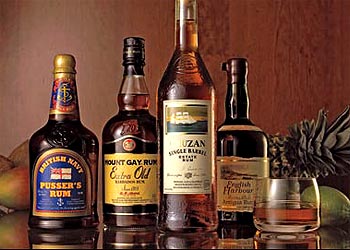 The common perception of rum is of a colourless spirit that goes with Coca cola, or strong, dark stuff drunk by the seafaring fraternity. In fact, rum has as many permutations of aromas, flavours and strengths as any group of malt whiskies would. Today rum is made in many countries: Australia, where it was the first drink of the infant colony, Latin America, even South Africa for example, but its home remains the Caribbean. Each of the main producing countries has its own distinctive style of rum, from the estery rums of Jamaica to the golden rums of Barbados, and the famous dark Demerara rums of Guyana. Rums range from sweet to dry, light to heavy, golden to dark, young to old. Even a single distillery, by the type of still it uses, the way it operates the still, and how the rum is matured and for how long, can create a broad range of different rums.
The common perception of rum is of a colourless spirit that goes with Coca cola, or strong, dark stuff drunk by the seafaring fraternity. In fact, rum has as many permutations of aromas, flavours and strengths as any group of malt whiskies would. Today rum is made in many countries: Australia, where it was the first drink of the infant colony, Latin America, even South Africa for example, but its home remains the Caribbean. Each of the main producing countries has its own distinctive style of rum, from the estery rums of Jamaica to the golden rums of Barbados, and the famous dark Demerara rums of Guyana. Rums range from sweet to dry, light to heavy, golden to dark, young to old. Even a single distillery, by the type of still it uses, the way it operates the still, and how the rum is matured and for how long, can create a broad range of different rums.
Lighter Rums are highly rectified (purified and blended) and are produced in column or continuous stills, after which they are usually charcoal-filtered and sometimes aged in old oak casks for a few months to add a degree of smoothness. Most light Rums have minimal flavour and aroma, and are very similar to Vodka, particularly those brands that have been charcoal-filtered. Heavier Rums are usually distilled in pot stills; similar to those used to produce Cognacs and Scotch whiskies. Pot stills are less "efficient" than column stills and some congeners (fusel oils and other flavour elements) are carried over with the alcohol. Some brands of Rum are made by blending pot and column distilled Rums in a manner similar to Armagnac production. But since all the rum in the world, regardless of which category it falls into, starts its life as white rum we could say that white rums are the foundation of the Rum Industry.
White Rums represent most of the rum sold in the world today, and are usually labeled by their manufacturers as White, Clear, Crystal, Cristal, Blanc, Blanco, Silver, Plata or Light.White Rums are light-bodied (although there are a few heavy-bodied White Rums from the French islands). They are usually clear and have a delicate and subdued flavour profile and like gin or Vodka, make for an excellent cocktail base blending particularly well with fruit flavours. There is a general misconception that white rums are not aged. This is not necessarily the case, for example, all white rums bottled in Puerto Rico have to have been aged for at least one year. Once the spirit has been aged the rum is drained from the barrel and then carbon filtered to remove the colour gained during the time spent in barrel. Some white rums such as Barcelo Gran Blanc are aged as many as four years. While Bacardi is the best known of white rums today, the Cuban produced Havana Club Anejo Blanco delivers a superior product for around the same price and is the quintessential Mojito Rum. Ron Matusalem Platino and El Doradoalso produce excellent white rums.
While Bacardi is the best known of white rums today, the Cuban produced Havana Club Anejo Blanco delivers a superior product for around the same price and is the quintessential Mojito Rum. Ron Matusalem Platino and El Doradoalso produce excellent white rums.
Golden Rums, also known as Amber Rums, are generally medium-bodied. Most have spent several years aging in oak casks, which give them smooth, mellow palates. Bacardi Oro is one of the most popular examples while Appleton Estate V/X from Jamiaca offers excellent quality and value for money.
Bacardi Oro is one of the most popular examples while Appleton Estate V/X from Jamiaca offers excellent quality and value for money.
Dark Rums are traditionally full-bodied, rich, caramel-dominated Rums. The best are produced mostly from pot stills and frequently aged in oak casks for extended periods. The richest of these Rums are consumed straight up and include British Navy Pussers Rum, El Dorado,Wood's 100, Myers's Original Dark Rum & Lamb's Navy Rum.
The richest of these Rums are consumed straight up and include British Navy Pussers Rum, El Dorado,Wood's 100, Myers's Original Dark Rum & Lamb's Navy Rum.
Spiced Rums can be white, golden, or dark Rums. They are infused with spices or fruit flavours. Rum punches (such as Planter's punch) are blends of Rum and fruit juices that are very popular in the Caribbean. Captian Morgan Spiced has done much to popularise this style in Western markets while El Dorado produce a natural and well made offering.
Captian Morgan Spiced has done much to popularise this style in Western markets while El Dorado produce a natural and well made offering.
Anejo and Age-Dated Rums are aged Rums from different vintages or batches that are mixed together to insure a continuity of flavour in brands of Rum from year to year. Some aged Rums will give age statements stating the youngest Rum in the blend (e.g., 10-year-old Rum contains a blend of Rums that are at least 10 years old). A small number of French island Rums are Vintage Dated. Havana Club Anejo 7 Year Old is a medium bodied aged rum from Cuba, while other highly regarded aged rums include Ron Matusalem Gran Reserva 15 Year Old from the Dominican Republic andMount Gay Extra Old- a perfectly mature Barbadian Anejo.
Havana Club Anejo 7 Year Old is a medium bodied aged rum from Cuba, while other highly regarded aged rums include Ron Matusalem Gran Reserva 15 Year Old from the Dominican Republic andMount Gay Extra Old- a perfectly mature Barbadian Anejo.
A Special Note on Rhum Agricole
As one of the last "hidden gems" in the world of spirits, this is a product faraway from the marketing ploys and bill boards of multinational brands. Not easily come by and even less widely known, although that's changing fast, it's represented by a handful of traditionalists who persist with sugarcane juice ("vin de canne", or 'sugarcane wine' as the French call it), rather than the way 99% of rum is made - from a waste product of sugar manufacturing we know as molasses. Agricole rums tend to be drier, more complex and diverse in flavour, rather than exuding overt sweetness, typified by subtle grassy / cane-like overtones and fresh, elegant profiles.
Ben Jones, North American regional director and spokesman for Martinique-based Rhum Clement, explains: “It’s a very dry and earthy, vegetal flavor profile, very different from the sort of medium-sweet, heavier, stickier profile that you get with the molasses foundation,” says Jones. “Fresh-pressed sugar cane juice is dry, not sweet. What makes molasses sweet is reducing it to super-concentrated sugar used for alcohol. Actual sugar, while it’s sweet, is not as sweet as people would perceive. It’s fruity and grassy, and the distillate of rhum agricole is really, truly the cleanest form of that distillate. The pun is horrible, but it’s like grass to glass.”
You could consider Agricoles the Caribbean’s equivalent to Bordeaux, not only because they taste more"European", but because Rum Agricole is the only rum to be governed by an AOC (Appellation d’Origine Controllee, the French official label of origin). Just as with French wine and food, this AOC dictates how the spirit can be made, including the mandate to harvest sugar cane only in the dry season, the prevention of burning of the cane fields and a requirement to press sugar cane into cane juice within three days of harvest.
Smaller scale production combined with these regulations makes for a winemaker's approach to rum. As they usually manage their own plantations, agricole distillers can harvest at the optimum time, rather than rely on the whim of private growers. They can also crush and begin fermentation immediately (sometimes with indigenous yeasts), a key factor in the category's style. Put simply, these rums taste fresher, not only for what they're made from, but because they are.
Because agricole's distinctive and diverse characteristics make even entry level expressions of considerable interest, cocktail geeks in the U.S. have been hooked on them for some time. Cask strength, vintage dated and ultra-aged bottlings are frequently nothing short of extraordinary, drawing comparisons with the very best Cognacs or Whiskies on the planet.
The total production of Rum Agricole combined make up about 1% of the Caribbean's total rum output, yet their influence is disproportionate. If you ignore the cynical trend towards luxury rums and super premium soleras, it's the agricoles that have injected added excitement into a category that was, six or seven years ago, wavering with a monotony of styles and mass marketed brands.
Clement and Rhum J.M. have become the most sought after names of Martinique. A little further north, the gold standard is Damoiseau - presently the only rum producer on the eastern side of Guadeloupe's Butterfly islands.
Rum Producing Regions(4)

The Caribbean is undeniably the epicenter of world Rum production with virtually every major island group producing its own distinct style.
Barbados produces light, sweetish Rums from both pot and column stills. Rum distillation began here and the Mount Gay Distillery, dating from 1663, is probably the oldest operating Rum producer in the world.
Cuba produces light-bodied, crisp, clean Rums from column stills. It is currently illegal to ship Cuban Rums into the United States.
The Dominican Republic is notable for its full-bodied, aged Rums from column stills.
Guyanais justly famous for its rich, heavy Demerara Rums, named for a local river, which are produced from both pot and column stills. Demerara Rums can be aged for extended periods (25-year-old varieties are on the market) and are frequently used for blending with lighter Rums from other regions. NeighboringSurinamandFrench Guyana produce similar full-bodied Rums.
Haiti follows the French tradition of heavier Rums that are double-distilled in pot stills and aged in oak casks for three or more years to produce full-flavored, exceptionally smooth- tasting Rums. Haiti also still has an extensive underground moonshine industry that supplies the voodoo religious ritual trade.
Jamaica is well known for its rich, aromatic Rums, most of which are produced in pot stills. Jamaica has official classifications of Rum, ranging from light to very full-flavoured. Jamaican Rums are extensively used for blending.
Martinique is a French island with the largest number of distilleries in the Eastern Caribbean. Both pot and column stills are used. As on other French islands such as Guadeloupe, both rhum agricole(made from sugar cane juice) and rhum industriel(made from molasses)are produced. These Rums are frequently aged in used French brandy casks for a minimum of three years. Rhum vieux(aged Rum)is frequently compared to high-quality French brandies.
Puerto Rico is known primarily for light, very dry Rums from column stills. All white Puerto Rican Rums must, by law, be aged a minimum of one year while dark Rums must be aged three years.
Trinidad produces mainly light Rums from column stills and has an extensive export trade.
The Virgin Islands, which are divided between the United States Virgin Islands and the British Virgin Islands, both produce light, mixing Rums from column stills. These Rums, and those of nearby Grenada, also serve as the base for bay Rum, a classic aftershave lotion.
Guatemala and Nicaragua are noteworthy in Central America where a variety of primarily medium-bodied Rums from column stills that lend themselves well to aging. They have recently begun to gain international recognition
Brazil produces much of the world's mollasses as well as vast quantities of mostly light Rums from column stills with un-aged cane spirit called Cachaca being the best-known example, though technically it is not a rum.
Venezuela makes a number of well-respected barrel-aged golden and dark Rums as well as being home to the famous rum based medicinal bitters, Angostura.
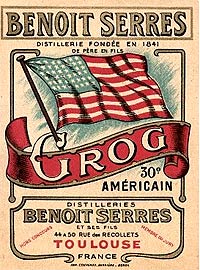 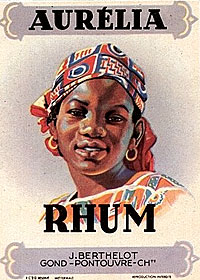 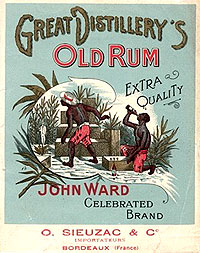 |
| Old rum labels: Some played on the many synonyms for rum, like "Grog", while others paid tribute to the spirit's dubious past in a curiously nonchalant way. |
Other Rum Producers around the World...
The United States has a handful of Rum distilleries in the south, producing a range of light and medium-bodied Rums that are generally marketed with Caribbean-themed names. Canada's 300-year-old tradition of trading Rum for dried cod fish continues in the Atlantic Maritime provinces of Newfoundland and Nova Scotia where golden Rums from Antigua, Barbados, and Jamaica are imported and aged for five years. The resulting hearty Rum is known locally as Screech. Europe is primarily a blender of imported Rums. Both the United Kingdom and France import Rums from their former colonies in the Caribbean for aging and bottling. Heavy, dark Jamaican Rums are imported into Germany and mixed with neutral spirit at a 1:19 ratio to produce Rum verschnitt. A similar product in Austria is called Inlander Rum. Australia produces a substantial amount of white and golden Rum in a double- distillation method utilizing both column and pot stills. Rum is the second most popular alcoholic beverage in the country after beer. Light Rums are also produced on some of the islands in the South Pacific such as Tahiti. Asian Rums tend to follow regional sugar cane production, with white and golden Rums from column stills being produced primarily in the Philippines and Thailand.
Rum Today
In the second half of the 20th century, modern air conditioning made it possible for large numbers of people to migrate to warm-weather regions where Rum remained the dominant spirit. Additionally, the explosive increase in the number of North American and European tourists into Rum-drinking regions has lead to a steady rise in the popularity of Rum-based mixed drinks. Nowadays White Rum gives Vodka serious competition as the mixer of choice in a number of distinctively non-tropical markets.
Classic rum is just as fine a spirit to any other, and the slow introduction of rums with an indication of age, and special bottlings of old rums, has given the spirit of the Caribbean a chance to show there is more to rum than just Coke. Aged Rums are gaining new standing among consumers of single malt Scotch whiskies, Armagnacs, and small-batch Bourbons who are learning to appreciate their subtle complexities. The pot still Rums of Guyana and Jamaica seem to have a particular appeal for Scotch whisky drinkers (it is no accident that the Scottish whisky merchant and bottler Cadenhead also ages and bottles Demerara Rum), while the subtle and complex rhums of Martinique and Guadeloupe mirror the flavour profiles of the top French brandies in Cognac and Armagnac. Super Premium Rums have also emerged: Trend-setter Bacardi has recently placed its "Millennium" brand on the market for $750 a fifth and Trinidad's historic producer of Angostura Bitters launched, with great marketing success, an "1824" label which costs four times what its equally smooth "Royal Oak" sells for. Even Australia, which has long supplied local rum lovers with the venerable, and overproof, "Bundaberg" rum, has marketed the extraordinarily silky "Beenleigh" , recently awarded the Gold medal for Dark Rum at the London International Wine and Spirits show, and the much praised "Inner Circle" Rums. These are but examples of whole new generation of upscale rums now coming from long-established distilleries in Venezuela, Colombia, Nicaragua, Panama and Guatemala. However, the Caribbean will be facing stiff competition from the likes of the Philippines and Brazil. Products like the Brazilian sugar cane-derived "Cachaca" which the Puerto Rican rum lobby has successfully kept out of the U.S. rum market as a non-rum, are taking full advantage of new import & export laws.
|
||
| Contemporary Rum Advertising: "Bacardi White Rum - A Fresh Diversion." Lime and mint are the key ingredients in a Mojito. The advertisement places a mint leaf on the models tongue, attributing sensuality to the product and making for an arresting image. The rum industry has followed other alcohol advertisers in employing erotic imagery to sell product. |
Drinking & Enjoying Rum
Rum is one of the most versatile spirits in the world. It can be served neat , on the rocks, or as an ingredient in hot or cold mixed drinks. Few drinking-age people are alive today who have not heard about such classic rum cocktails such as the Daiquiri, Mai Tai, Piña Colada and the Mojito(see below for recipes).It is perhaps due to the popularity of these tropical cocktails that rum is often linked to pirates, treasure islands and lost paradises. In rum-producing countries, rum is more than just a beverage that is created for local and/or foreign consumption. As Tequila has become for Mexico, Rum is often a national symbol, and as such, has connotations of pride and local identity. It seems every rum-producing country's culture has adopted the spirit of rum in more ways than one. In Jamaica, for example, rum is used to cure colds, ward off evil spirits, christen newborns and purify the dead. If building a house, you will be advised to sprinkle a bottle of rum around it after the foundation has been built to keep away the "duppies" (evil spirits). There is a very popular rum drink in the Dominican Republic called "Mamajuana" (or "Damajuana"), which, depending on the addition of particular ingredients, can be used as a cure for everything from digestive problems to virility. In St. Lucia (in the British West Indies), it is believed by many that peanuts have aphrodisiac effects on those who consume them. It was only natural that they would combine peanuts with rum to produce a very popular rum cream, known as "Nutz N Rum". Another aphrodisiac, popular around the Caribbean, is Bois Bandé, which is the bark of the tree Roupala Montana (from the Proteaceae family). People usually mix the bark of this tree with rum, let it soak for a couple of weeks and then filter and drink the rum. This same tree is known in Dominica as "gimauve" or "gommier tree", in Costa Rica as "danto amarillo" or "zorillo" and in Brazil "carne de vaca".

Invented in 1944 by Victor "Trader Vic" Bergeron. He recounts it was served to some friends from Tahiti, who promptly proclaimed "Mai Tai, Roa Ae!", which in Tahitian means "Out of this world, the best!". Mr. Bergeron was so put out by all of the various lounges that claimed to be the birthplace of the Mai Tai, that he contacted the friends he originally made his concoction for and had them sign an affidavit attesting to its origins. The drink can also include Pineapple, Orange Juice, and other fruity additives to increase its tropical flair.
- 30ml White Rum
- 30ml Gold Rum
- 15ml Orange Curaçao
- 15ml Almond Syrup or Amaretto
- 15ml fresh lime juice
- 30ml Dark Rum
- Method: Shake all but the dark rum with ice. Strain into old fashioned glass. Top with the dark rum. Garnish with a maraschino cherry. Note: Always use fresh lime juice. The float of dark rum on the top is an important addition, so be sure you use straws. - notes partially sourced from www.drinkboy.com
The Pina Colada
The Pina Colada was originally just the juice of a fresh pineapple served either strained (colada) or unstrained (sin colar). One of the earliest references to a drink called a Pina Colada, containing Rum, Coconut and Pineapple was from the April 16, 1950 edition of the New York Times: "Drinks in the West Indies range from Martinique's famous rum punch to Cuba's pina colada (rum, pineapple and coconut milk). Key west has a variety of lime swizzles and punches, and Granadians use nutmeg in their rum drinks." It is a delicious, fragrant and mellow drink in itself -- rapidly shaken up with ice, sugar, lime and white rum in delicate proportions.

- 30ml White Rum
- 15ml Malibu
- 30ml milk
- Pineapple Juice
- Method: Shake rum, Malibu and milk with ice in a cocktail shaker. Strain into a glass with ice. Fill up with pineapple juice.
The Strawberry Daiquiri
The Daiquiri is a family of cocktails whose main ingredients have traditionally been rum and lime juice. There are several versions however, with some like the Strawberry Daiquiri having a texture similar to a smoothie. Originally the drink was served in a tall glass packed with cracked ice. A teaspoon of sugar was poured over the ice and the juice of one or two limes was squeezed over the sugar. 30ml - 60ml of rum completed the mixture. The glass was then frosted by stirring with a long-handled spoon.
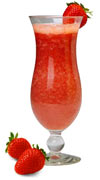
- 40 ml White Rum
- 20 ml Strawberry liqueur
- 3-4 strawberries (depending on their size)
- 40-60 ml lemon juice
- a cup of crushed ice
- Method: Mix in a blender until you have a thick mesh. Serve in a cocktail glass.
The Mojito
This traditional Cuban cocktail became popular in the United States during the late 1980's and has recently seen a resurgence in popularity. A Mojito (pronounced moh-HEE-toh) is made of five ingredients: mint, rum, sugar, lime juice, and club soda. Its combination of sweetness and refreshing citrus and mint flavours are intended to mask the potent kick of the rum, and have made the cocktail a popular summer drink. Mojitos were the second favourite drink (after Daiquiris) of the writer Ernest Hemingway. There are countless recipes for the Mojito , but this version is the one Hemingway himself enjoyed at the Mojito's place of birth: La Bodeguita del Medio in Havana, Cuba.
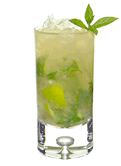
- 60 ml Havana Club White Rum
- 1-2 tbspoons sugar syrup
- 1 Lime
- a handful of fresh mint sprigs
- club soda
Method: Place the mint leaves into a long glass and squeeze the juice from a cut lime over it. You'll want about 60ml of lime juice, so it may not require all of the juice from a single lime. Add the powdered sugar, then gently smash the mint into the lime juice and sugar with a muddler (a long wooden device with a bulbous end, though you can also use the back of a fork or spoon if one isn't available). Add ice (preferably crushed) then add the rum and stir, and top off with the club soda. Garnish with a mint sprig.
Alternative: While the following isn't the original recipe for a Mojito, some people will take half of the juiced lime and cut into into four wedges to add to the glass. Another variation is to add Angostura bitters to cut the mojito's sweetness. Some Cubans also use "guarapo" in place of the powdered sugar, which is a sugar cane syrup.

1. Rum, by Dave Broom. Mitchell Beazley, United Kingdom, 2003
2. Spirits & Liqueurs, Peter Hallgarten. Faber & Faber, London 1979.
3. Rum, by Dave Broom. Mitchell Beazley, United Kingdom, 2003
4. Rum regions section sourced from www.tastings.com
Further education online: For an excellent online educational resource on Rum, visit The Rum University - www.rumuniversity.com and download the free online lessons.

